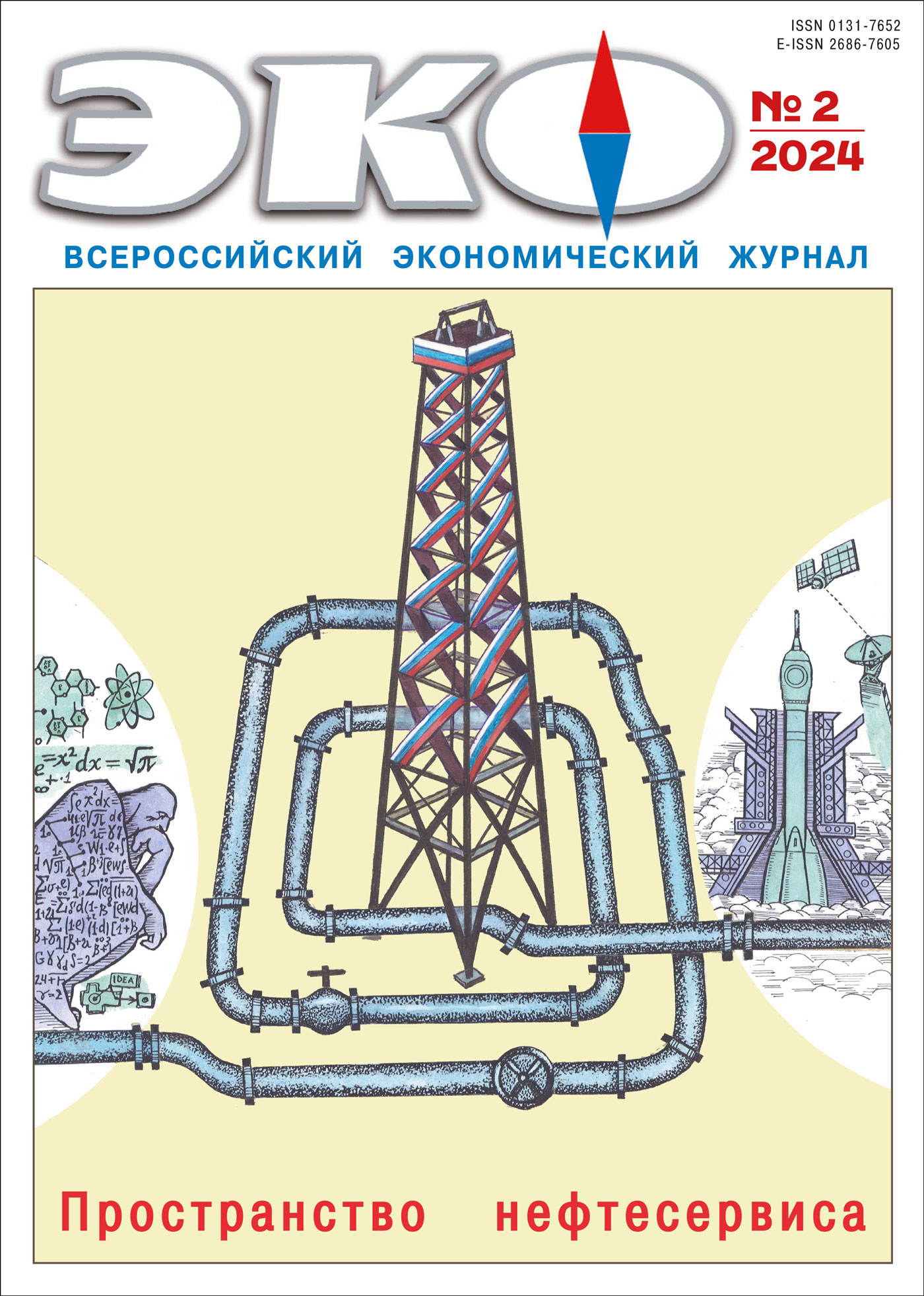Тема номера: Пространство нефтесервиса
Опубликован 08.04.2024
Ключевые слова
- нефтегазовый сервис; инновации; социально-экономическое развитие; налоги; ресурсный регион; знания
Как цитировать
1.
Крюков В, Токарев А. Нефтегазовый сервис: от мирового контекста к локальным знаниям и эффектам. ECO [Интернет]. 8 апрель 2024 г. [цитируется по 2 декабрь 2025 г.];54(2):8-28. доступно на: https://ecotrends.ru/index.php/eco/article/view/4718
Аннотация
В статье анализируются особенности развития нефтегазового сервиса в мировом и российском контексте. Показана инновационная роль сервиса в добыче углеводородного сырья, его значение в развитии отрасли и формировании социально-экономических эффектов. Авторы обосновывают, что модели инновационного развития в нефтегазовых регионах могут успешно развиваться на базе встраивания в них нефтегазового сервиса с учетом широкого спектра местных особенностей. Выполненные оценки показали, что нефтегазовый сервис играет важную роль с точки зрения налоговых доходов бюджетов и занятости. Полученные результаты демонстрируют необходимость усиления роли ресурсных регионов в регулировании нефтегазового сервиса и инновационных процессов.Библиографические ссылки
- Касаткин Д., Накорякова Л. Обзор рынка upstream и нефтесервиса – 2022. Аналитический центр Kasatkin Consulting, 2022. 18 с.
- Крюков В.А., Токарев А.Н. Локализация эффектов от развития нефтегазового комплекса как источник роста экономики Томской области // Томская область: трудный выбор своего пути. Новосибирск: ИЭОПП, 2014. С. 111–152.
- Лебедев Д. REnergyCO: Нефтесервисный рынок России в глобальном контексте // ROGTEC (Российские нефтегазовые технологии). 2022. № 68. С. 8–18.
- Шафраник, Ю.К., Крюков, В.А. Нефтегазовый сектор России: трудный путь к многообразию. М. и др.: Издательство «Перо». 2016. 270 с.
- Andersen, А., Mann, А., Simensen, Е. (2018). Innovation in natural resource-based industries: a pathway to development? Introduction to special issue. Innovation and Development. Vol. 8 (1). Pp. 1–27. DOI: 10.1080/2157930X.2018.1439293
- Asheim, B., Isaksen, A. (2002). Regional Innovation Systems: The Integration of Local ‘Sticky’ and Global ‘Ubiquitous’ Knowledge. The Journal of Technology Transfer. Vol. 27. Issue 1. Рp. 77–86. DOI: 10.1023/A:1013100704794
- Asheim, B., Isaksen, A. (1996). Location agglomeration and innovation: Towards regional innovation systems in Norway? – STEP group. Report 13–96. Oslo. 64 p.
- Audrectsch, D., Feldman, M. (2003). Knowledge Spillovers and the Geography of Innovation. Vol. 4. 45 p.
- Boshma, R. (2005). Proximity and Innovation: A Critical Assessment. Regional Studies. Vol. 39. Issue. 1. Pp. 61–74. DOI: 10.1080/0034340052000320887
- Ellison, G., Edward, L. (1999). The geographic concentration of industry: Does natural advantage explain agglomeration? Quarterly Journal of Economics. Vol. 35 (4). Pp. 311–316.
- Figueiredo, P.N., Piana, J. (2021). Technological learning strategies and technology upgrading intensity in the mining industry: evidence from Brazil. The Journal of Technology Transfer. Vol. 46. Pp. 629–659. DOI: 10.1007/s10961–020–09810–9
- Hu, J. (2014). Geographical Space Distribution of China’s Oil and Gas Industry: Characteristics and Drivers. Journal of Resources and Ecology. Vol. 5. Issue 1. Рp. 68–73.
- Isaksen, A., Karlsen, J. (2012). What is regional in regional clusters? The case of the globally oriented oil and gas cluster in Agder, Norway. Industry and Innovation. Vol. 19 (3). Pp. 249–263. DOI: 10.1080/13662716.2012.669616
- Kryukov, V., Tokarev, A. (2022а). Spatial trends of innovation in the Russian oil and gas sector: What does patent activity in Siberia and the Arctic reflect? Regional Science Policy and Practice. Vol.14. Issue 1. Pp. 127–146. DOI: 10.1111/rsp3.12445
- Kryukov, V.A., Tokarev, A.N. (2022b). The Oil Industry in the South of Tyumen Oblast: Enclaves or Clusters? Regional Research of Russia. Vol. 12. No. 2. Pp. 113–123. DOI: 10.1134/S2079970522020150
- Kryukov, V., Tokarev, A. (2023). Hard-to-recover oil reserves in the context of sustainable development of resource regions. E3S Web of Conferences. IVth International Conference “Energy Systems Research” (ESR-2023). Irkutsk, Russia. September 11–15. / eds. V. Stennikov, S. Senderov, A. Vichalevech, N.A. Yusifbayki. Vol. 470. Art. No. 01026. DOI: 10.1051/e3sconf/202347001026
- Lundvall, B.-A. (2004). The economics of knowledge and learning. Product Innovation, Interactive Learning and Economic Performance (Research on Technological Innovation, Management and Policy, Vol. 8). Christensen J., Lundvall B.-A. (ed.). Emerald Group Publishing Limited. Pp. 21–42.
- Moulaert, F., Sekia, F. (2003). Territorial Innovation Models: A Critical Survey. Regional Studies. Vol. 37. Issue. 3. Pp. 289–302. DOI: http://dx.doi.org/10.1080/0034340032000065442
- Perrons, R. (2014). How innovation and R&D happen in the upstream oil & gas industry: Insights from a global survey. Journal of Petroleum Science and Engineering. Vol. 124. Pp. 301–312. DOI: http://dx.doi.org/10.1016/j.petrol.2014.09.027
- Sasson, A., Blomgren, A. (2011). Knowledge Based Oil and Gas Industry. Research Report. No. 3. BI Norwegian Business School. Department of Strategy and Logistics. 131 p.
- Shearmur, R. (2010).Space, place and innovation: a distance-based approach. The Canadian Geographer. Vol. 54. Issue 1. Pp. 46–67. DOI: 10.1111/j.1541–0064.2009.00302.x
- Sukkoo, K. (1999). Regions, resources, and economic geography: Sources of U.S. regional comparative ad-vantage, 1880–1987. Regional Science and Urban Economics. Vol. 29 (1). Pp. 1–32.

